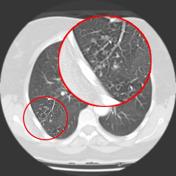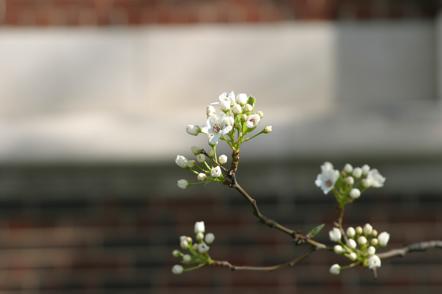tree in bud opacities pneumonia
Bronchial cystazygoesophgeal recesstypical location. It is most commonly associated with infectious diseases affecting the bronchioles1 OP resulting in a tree in bud pattern has been previously suggested2 However a clear radiological-pathological correlation of OP filling the bronchioles resulting in a tree in bud pattern has to the best of our knowledge not yet been clearly demonstrated.

Tree In Bud Caused By Haemophilus Influenzae Radiology Case Radiopaedia Org
Since the initial report of endobronchial spread of pulmonary tuberculosis the tree-in-bud sign has been reported in a wide variety of health conditions including infectious diseases aspiration pneumonia congenital disorders idiopathic disorders inhalation immunologic disorders connective disorders 23456 and central lung cancer involving the.

. Tree-in-bud opacities may be focal or multifocal unilateral or bilateral. Tree-in-bud opacities. These small clustered branching and nodular opacities represent terminal airway mucous impaction with adjacent peribronchiolar inflammation.
Organizing pneumonia most commonly results in a patchy bilateral consolidation that has a predominantly peribronchial and peripheral distribution on CT but it occasionally may be diffuse. Aspiration Pneumonia and Tree in Bud Sign 87 year old male with history of cough and suspicion of aspiration shows barium aspiration into the proximal trachea upper right The scout view upper right shows an infiltrate at the right base Thickened airways in the right lower lobe 2nd row left is associated with a pneumonic infiltrate in the right lower lobe lower right. When abnormal imaging will most often appear as a bronchiolitis tree-in-bud opacities on CT or subtle perivascular interstitial opacities on chest radiographs a bronchopneumonia tree-in-bud opacities and patchy regions of consolidation on CT or multifocal areas of consolidation on chest radiographs or as multifocal pneumonia multifocal areas of consolidation on CT and chest.
Foreign material entering into the tracheobronchial tree secondary to gastroesophageal reflux altered mental status drug overdose anesthesia or neurologic disorder stroke traumatic brain injury Often develops in intubated. Multiple causes for tree-in-bud TIB opacities have been reported. We here describe an unusual cause of TIB during the COVID-19 pandemic.
The tree-in-bud pattern is classically associated with endobronchial spread of tuberculosis or atypical mycobacterial infection. In clinical practice however it can reflect a wide variety of pathogens including bacterial fungal and viral organisms. Usually somewhat nodular in appearance the tree-in-bud pattern is generally most pronounced in the lung periphery and associated with abnormalities of the larger airways.
Although initially described in 1993 as a thin-section chest CT finding in active tuberculosis TIB opacities are by. No pleural or pericardial effusion. Often seen as tree-in-bud opacities bronchial wall thicken-ing bronchiolar dilatation often referred to as bronchiolecta-sis and mosaic attenuation andor air trapping if expiratory imaging is used.
It is commonly associated with bronchopneumonia viral bronchiolitis CMV respiratory syncytial virus endobronchial tuberculosis pneumocystis pneumonia invasive aspergillosis bronchioloalveolar cell carcinoma etc. Intravascular pulmonary tumor embolism often occurs in cancers of the breast liver kidney stomach prostate and ovaries and can lead to the tree-in-bud sign in HRCT 214. Malignancy can be associated with the tree-in-bud sign.
However to our knowledge the relative frequencies of the causes have not been evaluated. In the acute phase bacterial pneumonia manifests in the form of segmental or lobar consolidation Fig 2 possibly with cavitation and related hilar and mediastinal adenopathies. In radiology the tree-in-bud sign is a finding on a CT scan that indicates some degree of airway obstruction.
This is the classic appearance of the tree in bud pattern seen on chest ct. Tree-in-bud refers to a pattern seen on thin-section chest CT in which centrilobular bronchial dilatation and filling by mucus pus or fluid resembles a budding tree. Tree-In-Bud Pattern A lymphoid interstitial infiltrate in the walls of the small airways follicular bronchiolitis may cause small centrilobular nodules and the tree-in-bud pattern Fig.
A young male patient who had a history of fever cough and respiratory distress presented in the emergency department. Are tree-in-bud nodules cancerous. The tree-in-bud sign is a nonspecific imaging finding that implies impaction within bronchioles the smallest airway passages in the lung.
Tree in bud opacification refers to a sign on chest ct where small centrilobular nodules and corresponding small branches simulate the appearance of the end of a branch belonging to a tree that is in bud. Jennifer hong ba francisca zuazo md hanyuan shi md 1 1 tulane university la new orleans. Infectious bronchiolitis is by far the most common type of bronchiolitis and can be classified according to its clinical.
Causes and imaging patterns of tree-in-bud opacities. Tib opacities are also associated with bronchiectasis and small airways obliteration resulting in mosaic air trapping. Tree-in-bud TIB opacities are a common imaging finding on thoracic CT scan.
The differential for this finding includes malignant and inflammatory etiologies either infectious or sterile. Radiology scientific expert review panel. The tree-in-bud sign has been described in cases of acute aspiration 13.
The purpose of this study was to determine the relative frequency of causes of TIB opacities and identify patterns of disease associated with TIB opacities. The purpose of this study was to determine the relative frequency of. 1012 Poorly defined centrilobular nodules associated with branching linear and nodular opacities ie tree-in-bud sign are the typical HRCT findings of infective bronchiolitis frequently.
More extensive lympho - cytic infiltrations may be associated with lymphoid interstitial pneumonia LIP with ground-. While the tree-in-bud appearance usually represents an endobronchial spread of infection given the proximity of small pulmonary arteries and small airways sharing branching morphology in the bronchovascular bundle a rarer cause of the tree-in-bud sign is infiltration of the small pulmonary arteriesarterioles or. Similarly chronic eosinophilic pneumonia typically results in consolidation mainly in the peripheral lung regions but it may.
TIB opacities represent a normally invisible branches of the bronchiole tree 1 mm in diameter that are severely impacted with mucous pus or fluid with resultant dilatation and budding of the terminal bronchioles 2 mm in diameter1 photo. Tree-in-bud TIB appearance in computed tomography CT chest is most commonly a manifestation of infection.

References In Causes And Imaging Patterns Of Tree In Bud Opacities Chest

Tree In Bud Pattern Pulmonary Tb Eurorad

Hrct Scan Of The Chest Showing Diffuse Micronodules And Tree In Bud Download Scientific Diagram

Tree In Bud Sign And Bronchiectasis Radiology Case Radiopaedia Org

Tree In Bud Sign Lung Radiology Reference Article Radiopaedia Org

Afmr Tree In Bud Appearance On Ct Scan Of Chest

Tree In Bud Sign Lung Radiology Reference Article Radiopaedia Org

Tree In Bud Sign Lung Radiology Reference Article Radiopaedia Org
View Of Tree In Bud The Southwest Respiratory And Critical Care Chronicles

Tree In Bud Caused By Haemophilus Influenzae Radiology Case Radiopaedia Org

References In Causes And Imaging Patterns Of Tree In Bud Opacities Chest

Pdf Tree In Bud Semantic Scholar

References In Causes And Imaging Patterns Of Tree In Bud Opacities Chest